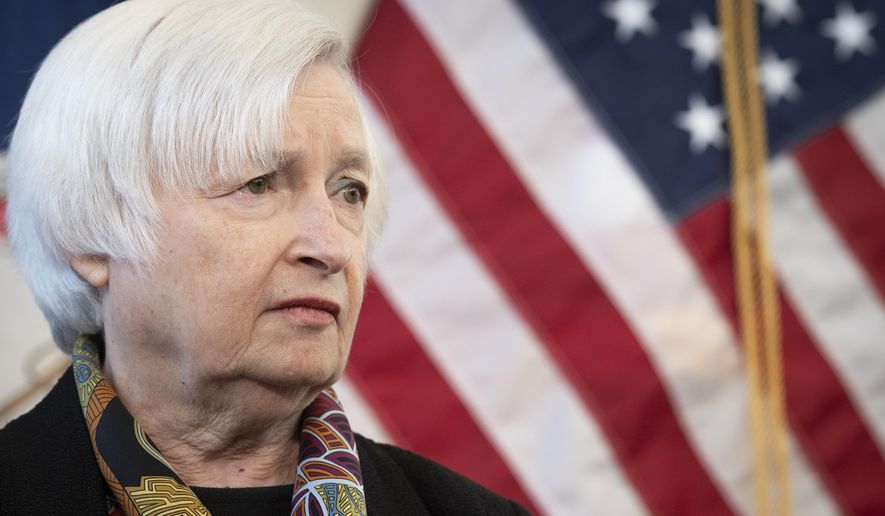The federal government will bump up against its borrowing limit this week, the Treasury Department said, putting Congress on notice that it must approve an increase or risk Uncle Sam not being able to cover the bills.
Secretary Janet Yellen said Friday her department will use other tools to cover payments, but those tools can only last so long. Once they run out, if Congress and President Biden haven’t agreed to an increase in borrowing authority, the government will be able to pay only according to income.
House Speaker Kevin McCarthy said he will hold true to his promise to block increasing the fiscal spending ceiling unless the Democratic-led Senate and the White House agree to hefty cuts in the face of overwhelming national debt.
“If you had a child, you gave them a credit card, and they kept hitting the limit, you wouldn’t just keep increasing it. You’d first see what you’re spending your money on. How can we cut items out?” the California Republican said on Fox News’ “Sunday Morning Futures with Maria Bartiromo.” “Every government has to do this. Every state has to balance their budget, county, city. For the White House to say they won’t even look at it, that they can’t find one penny out of $1 of eliminating waste, I think they’re just trying to put us into bankruptcy.”
The current debt limit is $31.381 trillion, which was set in mid-December 2021, when Congress approved a $2.5 trillion increase. It took roughly 13 months to pile up that much red ink.
Ms. Yellen said it’s too early to say how long her other tools can bridge the gap, though she said it will likely extend at least into June.
“I respectfully urge Congress to act promptly to protect the full faith and credit of the United States,” she said in her letter to Mr. McCarthy.
Raising the debt limit is always a tricky vote, with conservative lawmakers reluctant to approve massive increases that they say fuel the federal spending binge. Liberal lawmakers are usually more willing to approve increases, though they sometimes withhold votes to increase the pain for Republicans.
The next increase could be particularly rough for the new House GOP majority.
Conservatives have insisted they must win major concessions as part of any increase, though Democrats control the Senate and the White House and will be reluctant to deal.
Rep. Brendan Boyle, top Democrat on the House Budget Committee, underscored that view Friday after Ms. Yellen’s alert.
“Defaulting on the full faith and credit of the United States should never be an option, and I am tired of Republicans thinking it’s acceptable to use our economy as a political hostage to try and force an extremist and deeply unpopular agenda,” the Pennsylvania lawmaker said in a statement.
But Rep. Jason Smith, the new GOP chairman of the House Ways and Means Committee, said Americans viscerally feel the dangers of out-of-control spending after having watched Democrats run up the credit card over the last two years, producing the worst inflation in four decades.
“I urge President Biden and Majority Leader [Charles E. Schumer] to follow past precedent and work with House Republicans to find a commonsense, bipartisan path to putting America on a more sustainable fiscal trajectory and meet our debt obligations,” he said.
The debt debate comes as the government’s fiscal picture is looking grim.
The annual deficit peaked at $3.1 trillion in fiscal 2020 as proposals to address COVID-19 sent spending through the roof. The deficit slipped to $2.8 trillion in 2021 as the pandemic needs slackened a bit, then dropped to $1.4 trillion last year.
But three months into fiscal 2023, the deficit is ticking back up. It reached $421.4 billion over that period, compared with $377.7 billion in the same months last year.
The deficit is the current gap between revenue and spending. Debt is the accumulation of deficits over the years.
So far in 2023, Uncle Sam has brought in about $1 trillion in revenue but spent $1.4 trillion, meaning the government has had to borrow 29 cents for $1 spent.
If no debt increase is forthcoming, it’s not clear what exactly would happen. But one option is that the government would instantly be unable to borrow, so spending would be cut by 29%.
• Ramsey Touchberry contributed to this report.
• Stephen Dinan can be reached at sdinan@washingtontimes.com.




Please read our comment policy before commenting.